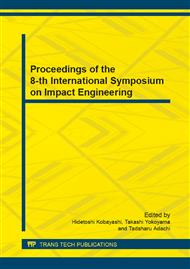p.581
p.586
p.593
p.599
p.605
p.611
p.617
p.623
p.629
Numerical Evaluation of Dynamic Behavior of Axial Crushing Honeycomb Based on Adhesively-Bonded Model
Abstract:
The axial crushing behavior of metal honeycomb was studied with laying emphasis on the effects of adhesively-bonded joint and strain rate dependence on its characteristics as an energy absorber. To introduce the influences of the plastic deformation of adhesive layer and the fracture of adhesively-bonded joint, the embedded-process-zone (EPZ) model was used. First, the axial crushing behavior of metal honeycombs (A3003 aluminum alloy and SUS430 stainless steel) was studied with changing the strain rate by low-speed and drop-weight experiments, and then the numerical model of honeycomb, which included EPZ model and the initial imperfection, was investigated by the explicit FEM code LS-DYNA. The mean buckling load calculated with EPZ model becomes smaller than that calculated with the combined model and agrees well with the experimental result. The effect of the strain rate dependence of material on the structure was also studied by the numerical simulation as well as by the experiment. A3003 honeycomb shows no strain rate dependence on the load –displacement relation while SUS430 honeycomb shows significant increase in the mean buckling load.
Info:
Periodical:
Pages:
605-610
Citation:
Online since:
June 2014
Authors:
Price:
Сopyright:
© 2014 Trans Tech Publications Ltd. All Rights Reserved
Share:
Citation:


